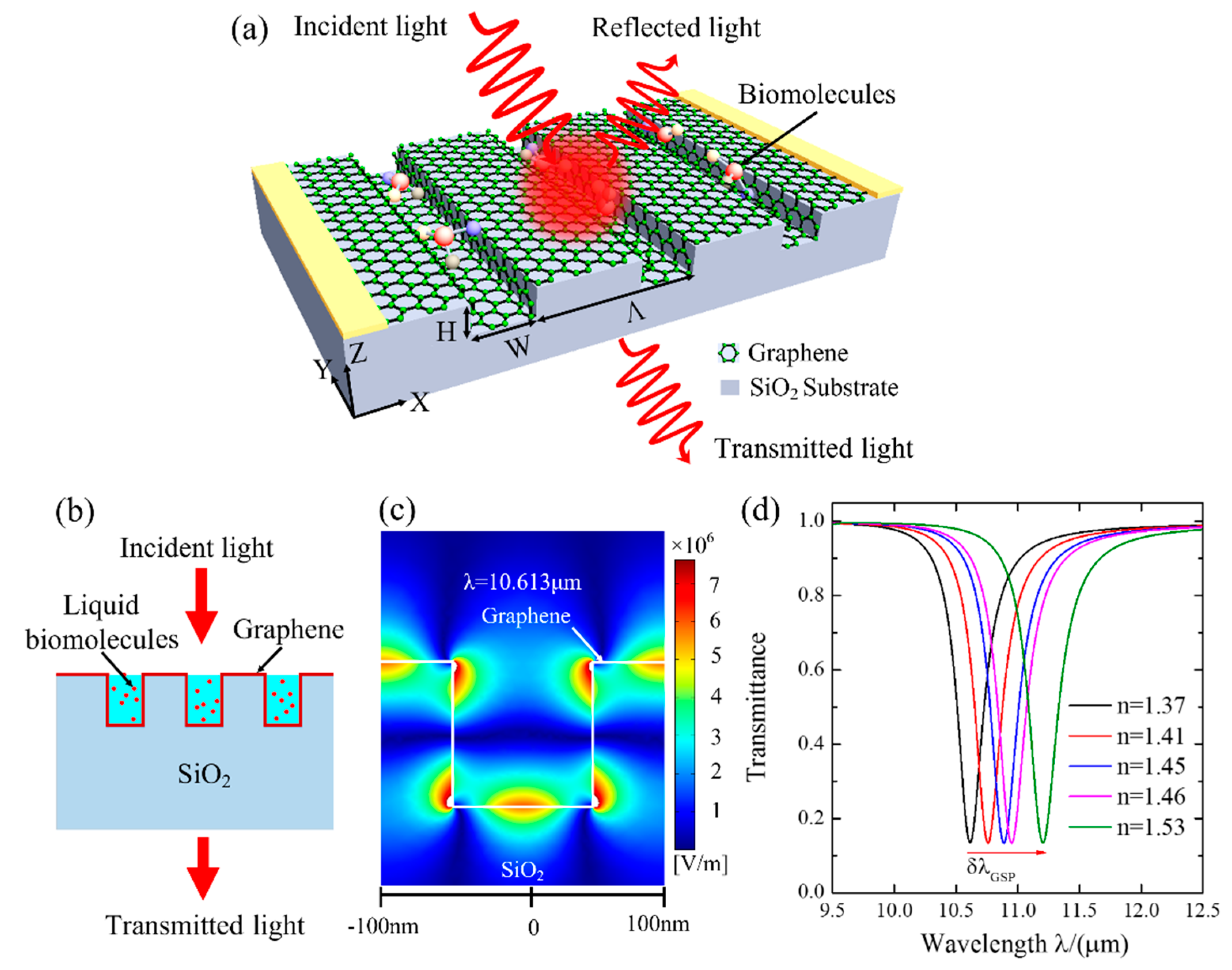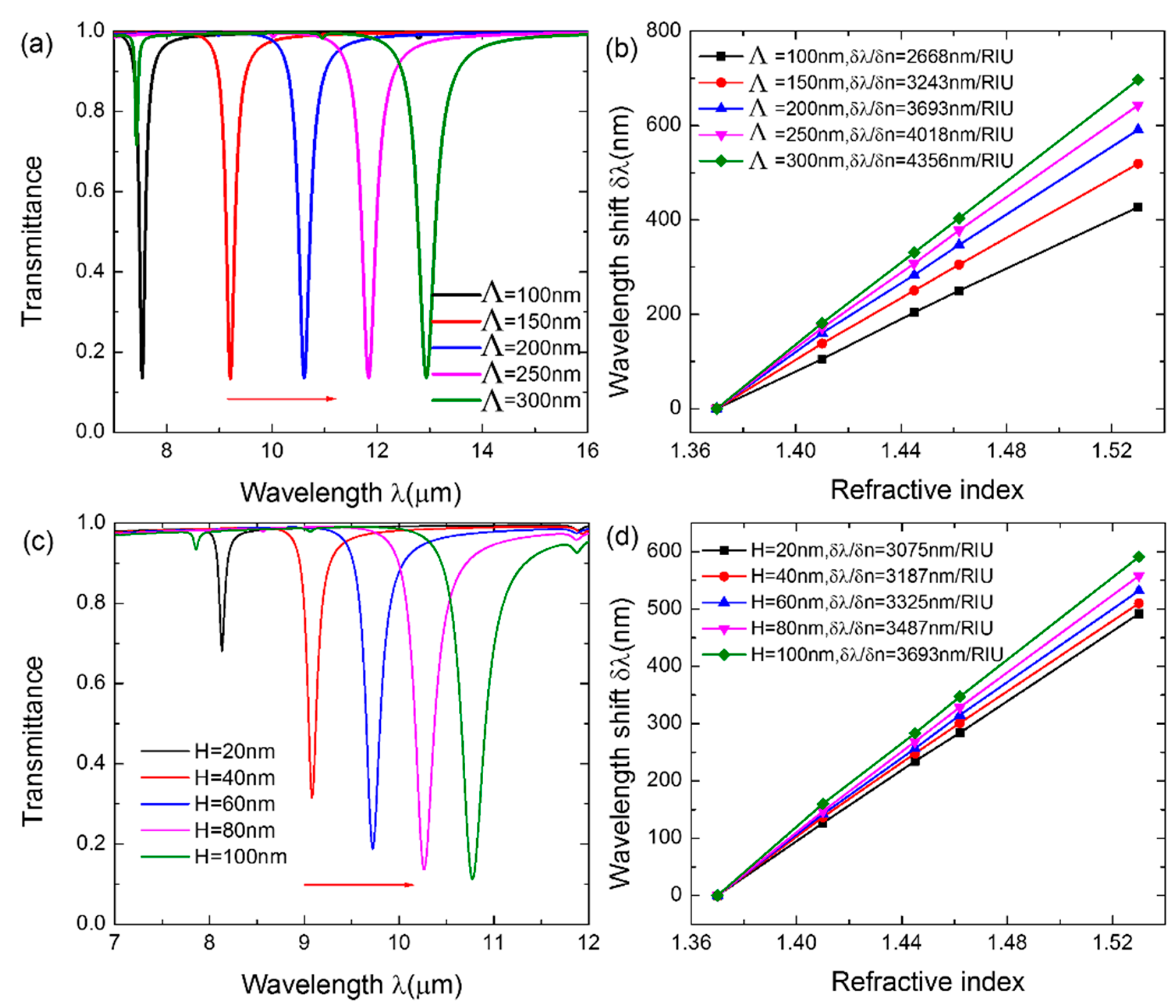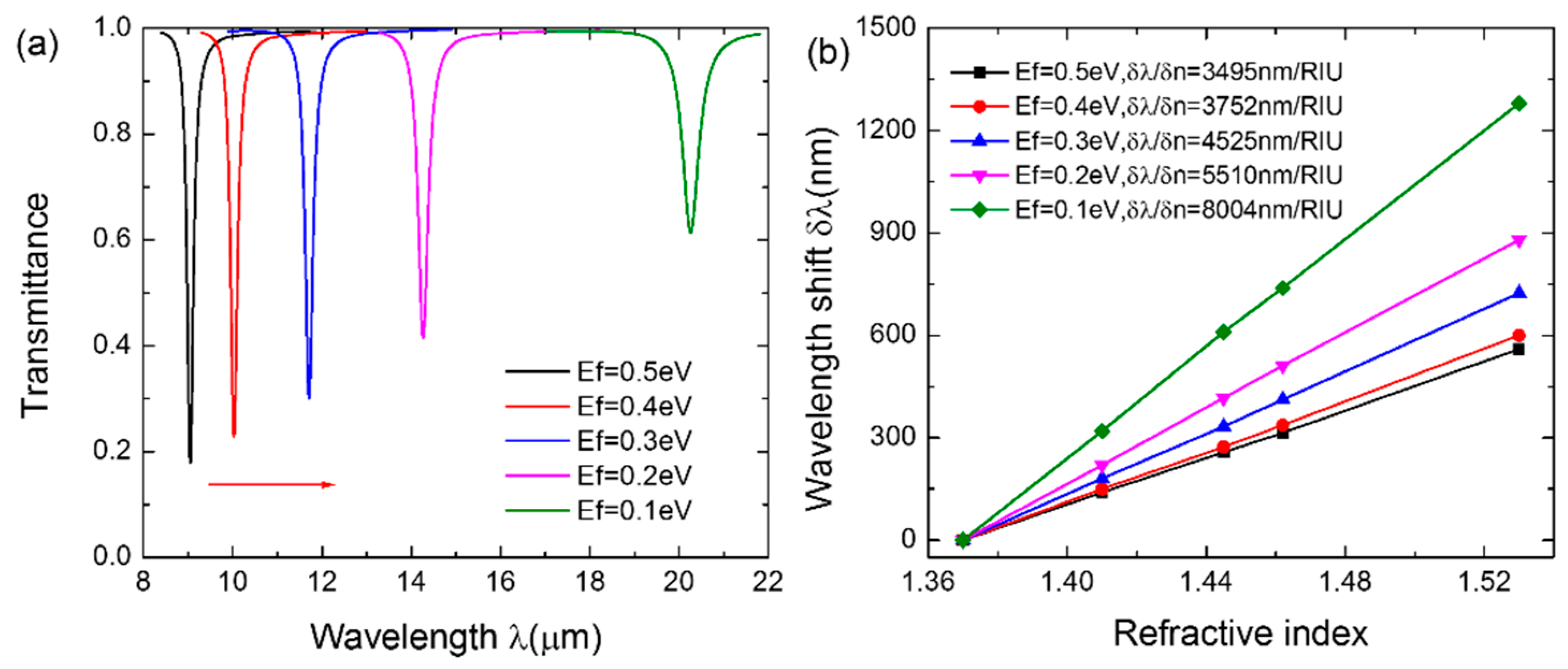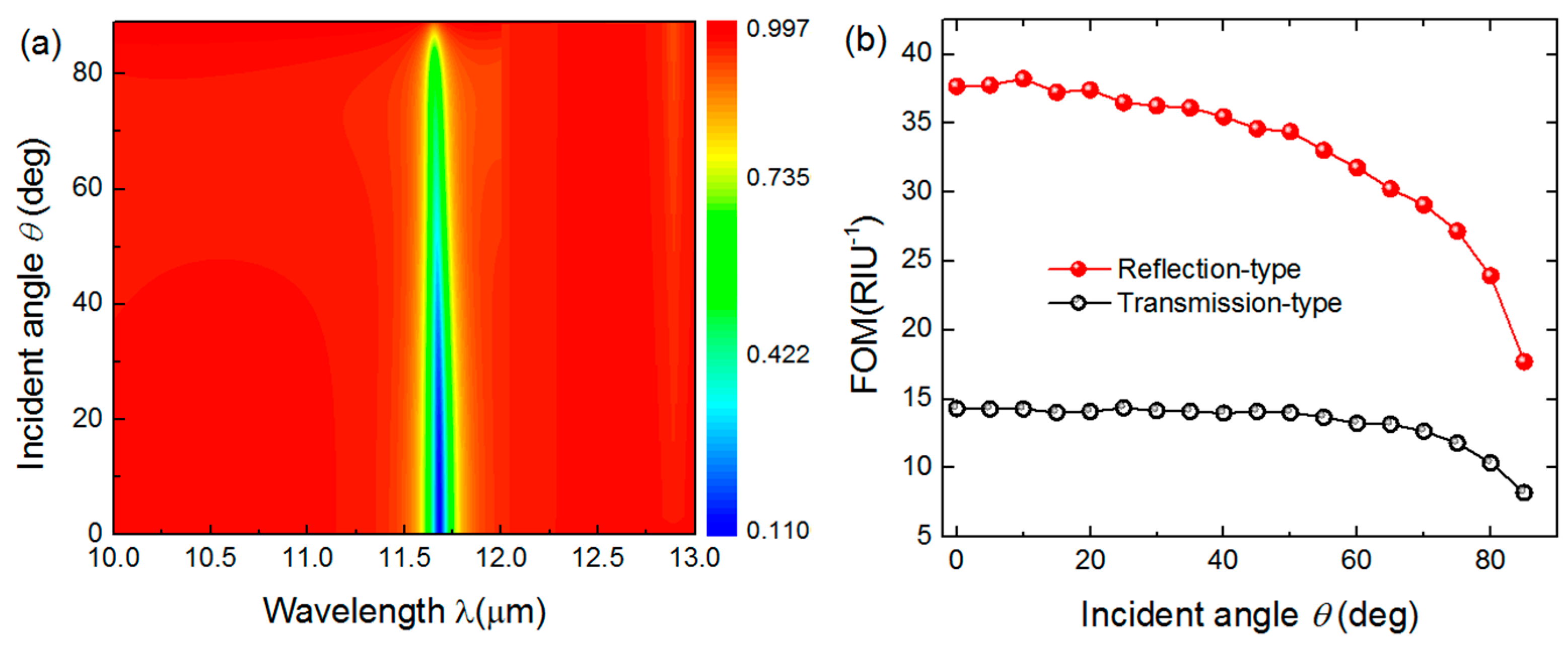Conformal Graphene-Decorated Nanofluidic Sensors Based on Surface Plasmons at Infrared Frequencies
Abstract
:1. Introduction
2. Structure and Principles
3. Improvement of the Sensitivity
3.1. Effect of the Structure Parameters of CGDNC on the Sensitivity
3.2. Effect of the Coupling of GSP Modes on the Sensitivity
3.3. Effect of the FERMI Level of Graphene on the Sensitivity
4. Improvement of the FOM
5. Conclusions
Acknowledgments
Author Contributions
Conflicts of Interest
References
- Acimovic, S.S.; Ortega, M.A.; Sanz, V.; Berthelot, J.; Garcia-Cordero, J.L.; Renger, J.; Maerkl, S.J.; Kreuzer, M.P.; Quidant, R. LSPR chip for parallel, rapid, and sensitive detection of cancer markers in serum. Nano Lett. 2014, 14, 2636–2641. [Google Scholar] [CrossRef] [PubMed]
- Yang, H.-M.; Ma, C.-W.; Wang, J.-Y.; Liu, J.; Chen, B.-X. Study of a symmetrically structured SPR sensor and its dual-wavelength differential method. J. Mod. Opt. 2015, 63, 85–91. [Google Scholar] [CrossRef]
- Mousavi, M.Z.; Chen, H.Y.; Lee, K.L.; Lin, H.; Chen, H.H.; Lin, Y.F.; Wong, C.S.; Li, H.F.; Wei, P.K.; Cheng, J.Y. Urinary micro-RNA biomarker detection using capped gold nanoslit SPR in a microfluidic chip. Analyst 2015, 140, 4097–4104. [Google Scholar] [CrossRef] [PubMed]
- Kretschmann, E. Die Bestimmung optischer Konstanten von Metallen durch Anregung von Oberflächenplasmaschwingungen. Z. Phys. 1971, 241, 313–324. [Google Scholar] [CrossRef]
- Xing, F.; Meng, G.X.; Zhang, Q.; Pan, L.T.; Wang, P.; Liu, Z.B.; Jiang, W.S.; Chen, Y.; Tian, J.G. Ultrasensitive Flow Sensing of a Single Cell Using Graphene-Based Optical Sensors. Nano Lett. 2014, 14, 3563–3569. [Google Scholar] [CrossRef] [PubMed]
- Joo, Y.H.; Song, S.H.; Magnusson, R. Demonstration of long-range surface plasmon-polariton waveguide sensors with asymmetric double-electrode structures. Appl. Phys. Lett. 2010, 97, 201105. [Google Scholar] [CrossRef]
- Nomura, K.; Gopinath, S.C.; Lakshmipriya, T.; Fukuda, N.; Wang, X.; Fujimaki, M. An angular fluidic channel for prism-free surface-plasmon-assisted fluorescence capturing. Nat. Commun. 2013, 4, 2855. [Google Scholar] [CrossRef] [PubMed]
- Law, S.; Yu, L.; Rosenberg, A.; Wasserman, D. All-semiconductor plasmonic nanoantennas for infrared sensing. Nano Lett. 2013, 13, 4569–4574. [Google Scholar] [CrossRef] [PubMed]
- Zhao, Y.; Hu, X.; Chen, G.; Zhang, X.; Tan, Z.; Chen, J.; Ruoff, R.S.; Zhu, Y.; Lu, Y. Infrared biosensors based on graphene plasmonics: Modeling. Phys. Chem. Chem. Phys. 2013, 15, 17118–17125. [Google Scholar] [CrossRef] [PubMed]
- Geim, A.K.; Novoselov, K.S. The rise of graphene. Nat. Mater. 2007, 6, 183–191. [Google Scholar] [CrossRef] [PubMed]
- Georgakilas, V.; Otyepka, M.; Bourlinos, A.B.; Chandra, V.; Kim, N.; Kemp, K.C.; Hobza, P.; Zboril, R.; Kim, K.S. Functionalization of graphene: Covalent and non-covalent approaches, derivatives and applications. Chem. Rev. 2012, 112, 6156–6214. [Google Scholar] [CrossRef] [PubMed]
- Grigorenko, A.N.; Polini, M.; Novoselov, K.S. Graphene plasmonics. Nat. Photonics 2012, 6, 749–758. [Google Scholar] [CrossRef]
- Tang, L.; Du, J.; Du, C.; Zhu, P.; Shi, H. Scaling phenomenon of graphene surface plasmon modes in grating-spacer-graphene hybrid systems. Opt. Express 2014, 22, 20214–20222. [Google Scholar] [CrossRef] [PubMed]
- Vasić, B.; Isić, G.; Gajić, R. Localized surface plasmon resonances in graphene ribbon arrays for sensing of dielectric environment at infrared frequencies. J. Appl. Phys. 2013, 113, 013110. [Google Scholar] [CrossRef]
- Wei, W.; Nong, J.; Tang, L.; Zhang, G.; Jiang, X.; Zhu, Y. Reflection-type infrared biosensor based on surface plasmonics in graphene ribbon arrays. Chin. Opt. Lett. 2015, 13, 082801. [Google Scholar] [CrossRef]
- Zhao, Y.; Chen, G.; Tao, Z.; Zhang, C.; Zhu, Y. High Q-factor plasmonic resonators in continuous graphene excited by insulator-covered silicon gratings. RSC Adv. 2014, 4, 26535. [Google Scholar] [CrossRef]
- Liu, F.; Cubukcu, E. Tunable omnidirectional strong light-matter interactions mediated by graphene surface plasmons. Phys. Rev. B 2013, 88, 115439. [Google Scholar] [CrossRef]
- Wei, W.; Nong, J.; Zhang, G.; Zhu, Y. An infrared biosensor based on graphene plasmonic for integrated nanofluidic analysis. Proc. SPIE 2014, 9278, 92780F. [Google Scholar]
- Capmany, J.; Domenech, D.; Muñoz, P. Silicon graphene waveguide tunable broadband microwave photonics phase shifter. Opt. Express 2014, 22, 8094. [Google Scholar] [CrossRef] [PubMed]
- Liu, P.; Zhang, X.; Ma, Z.; Cai, W.; Wang, L.; Xu, J. Surface plasmon modes in graphene wedge and groove waveguides. Opt. Express 2013, 21, 32432–32440. [Google Scholar] [CrossRef] [PubMed]
- Liu, M.; Yin, X.; Zhang, X. Double-layer graphene optical modulator. Nano Lett. 2012, 12, 1482–1485. [Google Scholar] [CrossRef] [PubMed]
- Rafiee, J.; Mi, X.; Gullapalli, H.; Thomas, A.V.; Yavari, F.; Shi, Y.; Ajayan, P.M.; Koratkar, N.A. Wetting transparency of graphene. Nat. Mater. 2012, 11, 217–222. [Google Scholar] [CrossRef] [PubMed]
- Zhan, T.; Zhao, F.; Hu, X.; Liu, X.; Zi, J. Band structure of plasmons and optical absorption enhancement in graphene on subwavelength dielectric gratings at infrared frequencies. Phys. Rev. B 2012, 86, 165416. [Google Scholar] [CrossRef]
- Gao, W.; Shi, G.; Jin, Z.; Shu, J.; Zhang, Q.; Vajtai, R.; Ajayan, P.M.; Kono, J.; Xu, Q. Excitation and active control of propagating surface plasmon polaritons in graphene. Nano Lett. 2013, 13, 3698–3702. [Google Scholar] [CrossRef] [PubMed]
- Ju, L.; Geng, B.; Horng, J.; Girit, C.; Martin, M.; Hao, Z.; Bechtel, H.A.; Liang, X.; Zettl, A.; Shen, Y.R.; et al. Graphene plasmonics for tunable terahertz metamaterials. Nat. Nanotechnol. 2011, 6, 630–634. [Google Scholar] [CrossRef] [PubMed]
- Jablan, M.; Buljan, H.; Soljačić, M. Plasmonics in graphene at infrared frequencies. Phys. Rev. B 2009, 80, 245435. [Google Scholar] [CrossRef]
- Lin, K.; Lu, Y.; Chen, J.; Zheng, R.; Wang, P.; Ming, H. Surface plasmon resonance hydrogen sensorbased on metallic grating with high sensitivity. Opt. Express 2008, 16, 18599–18604. [Google Scholar] [CrossRef] [PubMed]
- Mayer, K.M.; Hafner, J.H. Localized surface plasmon resonance sensors. Chem. Rev. 2011, 111, 3828–3857. [Google Scholar] [CrossRef] [PubMed]
- Tang, L.; Shi, H.; Yang, J.; Du, C.; Gao, F.; Zhu, J.; Du, J. Complete optical absorption in graphene by using nano-gratings to excite graphene surface plasmons. Microelectron. Eng. 2015, 145, 58–61. [Google Scholar] [CrossRef]






© 2016 by the authors; licensee MDPI, Basel, Switzerland. This article is an open access article distributed under the terms and conditions of the Creative Commons Attribution (CC-BY) license (http://creativecommons.org/licenses/by/4.0/).
Share and Cite
Wei, W.; Nong, J.; Tang, L.; Zhang, G.; Yang, J.; Luo, W. Conformal Graphene-Decorated Nanofluidic Sensors Based on Surface Plasmons at Infrared Frequencies. Sensors 2016, 16, 899. https://doi.org/10.3390/s16060899
Wei W, Nong J, Tang L, Zhang G, Yang J, Luo W. Conformal Graphene-Decorated Nanofluidic Sensors Based on Surface Plasmons at Infrared Frequencies. Sensors. 2016; 16(6):899. https://doi.org/10.3390/s16060899
Chicago/Turabian StyleWei, Wei, Jinpeng Nong, Linlong Tang, Guiwen Zhang, Jun Yang, and Wei Luo. 2016. "Conformal Graphene-Decorated Nanofluidic Sensors Based on Surface Plasmons at Infrared Frequencies" Sensors 16, no. 6: 899. https://doi.org/10.3390/s16060899
APA StyleWei, W., Nong, J., Tang, L., Zhang, G., Yang, J., & Luo, W. (2016). Conformal Graphene-Decorated Nanofluidic Sensors Based on Surface Plasmons at Infrared Frequencies. Sensors, 16(6), 899. https://doi.org/10.3390/s16060899






